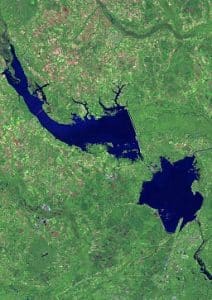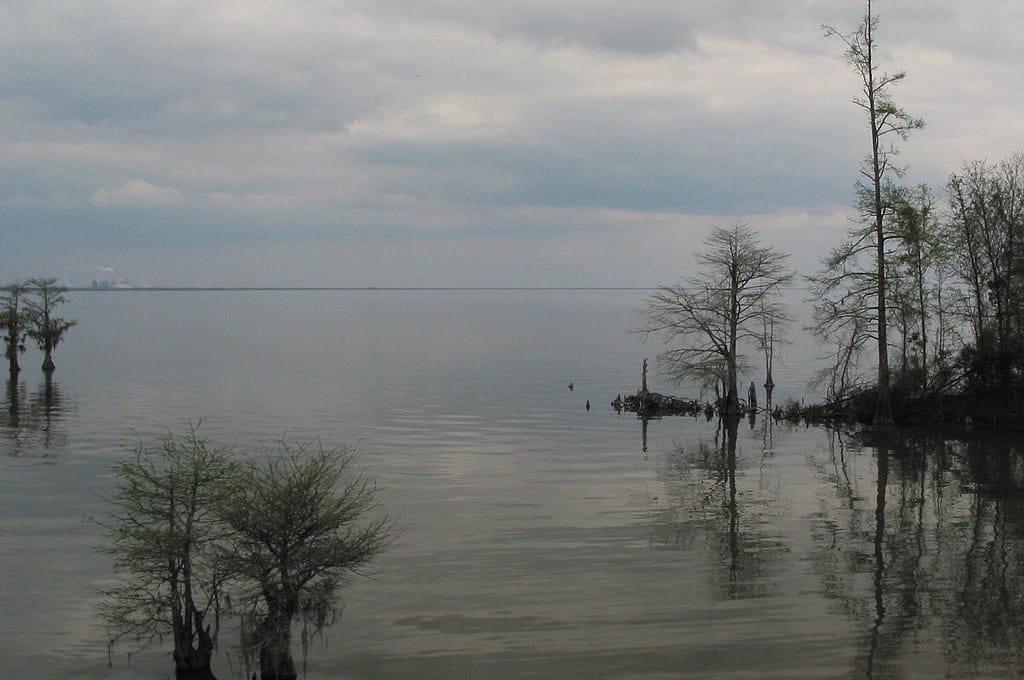Fishing at the Santee Cooper can be amazing with trophy-size fish being a regular item on the end of your fishing pole.
The Santee Cooper region boasts a good many tourist attractions for the whole family from historical sites, state parks, numerous golf courses, and great resorts.
Everyone will find something to love in addition to the great fishing.
Santee Cooper Reservoir
Santee Cooper Reservoir is an exciting fishery that has produced trophy fish over and over again.
You are in for a treat when you fish the Santee-Cooper and you want to set aside a few days to fully enjoy all it has to offer.
Santee-Cooper is easily reached via Hwy US 95 which actually crosses over Marion Lake and SR 6 which tracks the South side of both lakes and SR 52 which lies along the end of Lake Moultrie.
Lake Moultrie of the Santee Cooper is approximately 30 miles north of Charleston.
There are 450 miles of shoreline around 171,000 acres of water which comes to 6.5 million gallons. Lake Marion is 110,600 acres and Moultrie is 60,400 acres. That’s a lot of water and a lot of fish.
The lake system itself covers about 42 miles end to end.
Species at this location:
- Bass Striped
- Bass White
- Bream
- Catfish Blue
- Catfish Channel
- Crappie White
- Tilapia
Santee Cooper Lakes

The Santee Cooper Reservoir is actually two lakes, Marion and Moultrie.
Water arrives from the Congaree River and the Wateree River emptying into Lake Marion which in turn feeds Lake Moultrie through the Channel Canal.
The Santee River exits from Lake Marion and the Cooper River exits from Lake Moultrie.
Santee Cooper Lakes have a varying make-up of open water, backwater, inlets, clear areas, and woody areas so the habitat is fish friendly.
Lake Marion was not completely cleared leaving lots of stumps and standing dead trees underwater.
Lake Moultrie is more open and is 14 miles across at its widest point.
Through good planning, about 70% of the land adjacent to the lakes is mostly undeveloped so there is an abundance of wildlife and good habitat.
Santee Cooper Fishing
While not impossible to use fly gear, the Santee-Cooper is really a spinning or casting rod type of place. Recommended tackle includes 8 to 9-foot rods, free spool reels with clickers, and a 20 to 30-pound test line.
The terminal tackle includes 1 to 2 ounces sliding egg sinkers rigged above a barrel swivel with an 18 to 24-inch stock leader 5/0 or 6/0 offset hook.
You can fish from the shore or use a boat.
A boat is the most productive method given the size and make-up of the water but the shore caster can bring in some beauties. The abundance of structure on the lake bottoms means live bait, drop shots, jerk baits, soft plastics, and spinner lures are all in vogue here.
Use a line that can take a beating. If you want to do some fly fishing, the rivers below the dams are good places to go and quite productive.
Bream
Bream begin to bed down in water six inches to four feet deep as spring turns mild and will continue to bed monthly on each full moon into the fall, moving to deeper water as the days turn cooler. Crickets and worms on #6 hooks are the baits of choice.
Observant fishermen can try for bream during late April and May when Mayfly hatches occur. Fly fishing is very productive at this time.
Crappie
In late February, crappie congregates in the mouths of creeks at depths of 8 to 12 feet. During this time, limited catches are frequently made by drift fishing with minnows.
As the surface water temperature nears 58 to 64 degrees they move into water 2 to 12 feet deep to spawn. Black crappie deposit eggs on the bottom, and white crappie attach their eggs to brush or plants.
Warm spring rains frequently bring crappie to creek inlets in shallow water. Depending on water temperature, the spawning cycle for crappie lasts from the full moon in March to the full moon in May.
Medium-size minnows worked over brush at depths of 2 to 12 feet are the most popular bait. Small jigs or spoons on light tackle are also effective.
By mid-May crappie begin to move to the stumps and somewhat deeper water. Crappie are found deep around the dead trees of Lake Marion and deeply submerged brush piles of Moultrie. The depths range from 20 to 40 feet. Live medium minnows are the best bait.
From early October until winter the crappie will move to slightly more shallow water in the dead tree fields and brush piles. “Stump-Jumping” with live medium minnows is the best fishing method at this time.
Jigging with small jigs and quarter-ounce spoons is very effective on drop-offs with the brush.
“Stumpjumping” is not as effective now as the crappie tends to remain deep in tight concentrations. Live medium minnows are still the best bait.
Catfish
Blue catfish came to Santee Cooper in 1964 and 1965 when a total of 825 fish weighing about a pound each were obtained from Arkansas in exchange for striped bass fry produced at the Moncks Corner hatchery.
The fishermen who pursue this species stand excellent chances of boating some really big fish.
In the spring and summer of 1979, the lake (state) record was broken five times.
Blue catfish weighing 20 to 35 Ibs. are common in our lakes. Their range includes deep water holes and drop-offs throughout the lakes.
April through October are the best months for blue catfish. Cut herring, gizzard shad, mullet, worms and commercially prepared baits are effective.
Blue catfish are principally bottom feeders however, anglers land many fish trolling small lures or jigging spoons in mid-depths.
White Bass
White bass are not native to South Carolina but were stocked in 1952 from specimens originating in Tennessee.
White bass concentrate in schools primarily in open water areas over bare sandy points in 8 to 12 feet of water. The schools are most active from April through May and August through September.
Favorite baits are jigs, spoons, minnows, and spinners. They average less than a pound.
Largemouth Bass
Spring – When water temperatures reach 64 to 70 degrees the male constructs a nest in one to five feet of water and approximately 20 to 30 feet from the closest neighbor. The female lays 10,000 to 11,000 eggs which are fertilized, guarded, and maintained until the young fry disperse.
This is the best time of the year to catch big bass. Big females strike to protect beds if small buck bass doesn’t hit first.
Spoons, spinners, and six to eight-inch plastic worms are effective. After spawning, worms, crankbaits, and spinner baits are effective around the cypress trees’ stickups, lily pads, and grass beds in water 2 to 4 feet deep.
Summer – Most bass head for deeper water ledges and drops where heavily weighted jugs or worms are effective. Early and late in the day, the bass will often feed in the shallows.
Bass are usually found in waters less than 20 feet deep and rarely go beyond the area where rooted vegetation will grow.
Fall – Largemouth move into more shallow water and cypress, gum, and tupelo trees where plastic worms, spinner baits, and crank-down lures are effective.
Each tree must be fished completely from all angles for maximum results. Fishing points in the early morning is effective using plastic worms and crankbaits.
Winter – Bass move back to deep water where jigs, spoons, and heavily weighted worms are productive. At this time of year fish the lure very slowly.
Striped Bass
The striped bass story on the Santee Cooper Lakes is one of the greatest fish stories of all time.
The Santee dam across the Santee River impounded Lake Marion in 1942. It was found that the stripers that came up the Cooper River, from the ocean to spawn, entered Lake Moultrie through the Pinopolis Lock and became trapped or landlocked and therefore, could not return to the sea.
By a happy quirk of nature, the Santee Cooper lakes and rivers leading to them were ideal freshwater habitats for what was a saltwater fish. Since that time, stripers have been spawning and living year-round in the Santee Cooper lakes system.
Spring – In March, April, and May stripers make their way up through the diversion canal and generally by way of the riverbeds in the lakes, up the Congaree and Wateree Rivers for their annual spawning run.
As a result, fishermen concentrate on the rivers and Lake Marion.
During this period, live herring is the best bait followed by cut bait. The fish are concentrated in deep holes. Herring is sold at most fish camps.
Summer – After spawning, stripers head back down the rivers and into the lakes and deep water where herring is effective along the old sunken river channels.
When the weather gets hot, they are found in the deepest holes in the lake.
Fall – In September and October stripers start to school and frequently surface as they chase the gizzard shad. Anglers drift in these areas jigging the bottom with spoons and bucktails.
Drifting with large shiners is also highly productive.
Anglers are also looking for flocks of seagulls feeding on the shad which the stripers chase to the surface. Once a flock is spotted the boats race to the spot.
Do not run over the school and scare them down. At the school use topwater lures or poppers if they are on the surface. If they sound use fast sinking lures such as spoons or bucktails.
When fishing schools in this manner please respect the right of other fishermen. Do not infringe on their space. Also, do not get too close to the school and scare them. This will spoil everyone’s chance at the school.
Winter – Stripers are in deep water where drifting with large shiners minnows is effective. Use the same tackle as with herring, switching to smaller hooks and sinkers.
Best Season for Fishing at Santee Cooper
The Santee-Cooper is a year-round fishery with fishing being productive all year long.
South Carolina’s climate is humid and subtropical, with long, hot summers and short, mild winters.
The average temperature range is 32º-55ºF in January and 70º-92ºF in July.
Most of the state receives, on average, 49 inches of precipitation per year. Nearly all of it falls during the Spring and Summer

